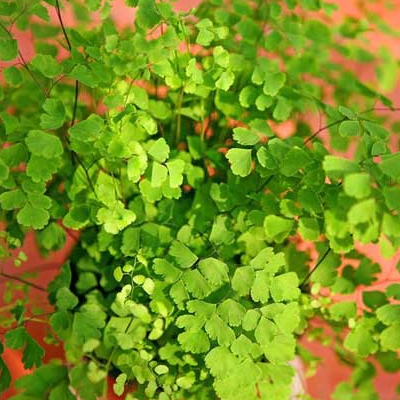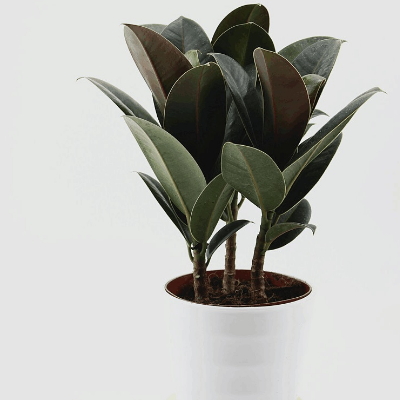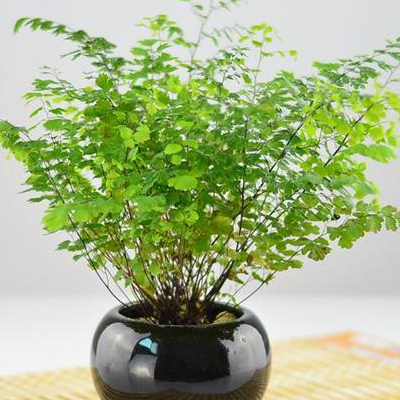Can Dryopteris fern be hydroponically cultured? what if the leaves wither?
Dryopteris is a very good family potted plant, but also very ornamental, so can Dryopteris can be hydroponically cultivated? What if the leaves of Dryopteris fern wither?

Can Dryopteris przewalskii be cultured in water?
Dryopteris can be cultured in water. Dryopteris likes humid environment, the suitable temperature for growth is 21-25 ℃ during the day and 12-15 ℃ at night. The leaves can still keep fresh green when the temperature is above 5 ℃, but when the temperature is lower than 5 ℃, the leaves will appear freezing injury, like bright scattered light and afraid of direct sunlight, so it is one of the common hydroponic plants.
First wash the root of the fern, disinfect it with potassium fern, then find a container to add water, match it with a proper proportion of nutrient solution (which can be bought on the market), or fix it on the mouth of the container or on the surface of the water, the fern should be planted on the coral stone, stick it, and then put the coral stone in the water to grow well after survival. When hydroponic culture, we should pay attention to the coral stone to use water bubble to remove salt, the water should not flood the head of Dryopteris, in order to let the stone grow moss, can not be kept indoors for a long time.
What if the leaves of Dryopteris fern wither:
Because it likes to grow in a warm and humid environment, it can not be short of water for a long time, so it is necessary to maintain a relatively humid basin soil, and there are no shortcuts. You must always observe and take care of it.
Dryopteris likes shade and is afraid of light, so it can not grow smoothly under strong light. Potted plants should be cultured in half-day shade or indirect light in the shed, and avoid sun exposure in summer. The growing season should be fully watered.
Usually can be watered once a day, summer can be watered twice a day, and maintain a high air humidity; summer high temperature season should also spray water to the leaves 2 or 3 times a day to keep the leaves green, and the basin can be soaked in water once a week. After the end of autumn, the watering times should be gradually reduced to keep the basin soil moist and enhance its cold resistance.
When the water is insufficient, the leaves are easy to turn yellow. However, if the soil moisture is too saturated, or if the root is too dry, it will wilt or even die. The amount of fertilizer required is not much, liquid fertilizer can be applied once in 15-30 days during the growing period, and nitrogen fertilizer can be applied at the seedling stage. Do not stain the leaves when applying fertilizer, otherwise the leaves will be withered and yellow and the ornamental value will be reduced.
Dryopteris przewalskii has strong adaptability and fast growth. Overdense leaf clusters will lead to weak growth and yellowing leaves, so it should be propagated or changed in time. Dryopteris likes calcium fertilizer. When changing the basin, you can add a small amount of lime and broken eggshell to the basin to add some calcium fertilizer. Too dense foliage is not conducive to the germination of new leaves, which can be properly pruned in autumn to remove some old leaves and yellow leaves in order to keep the plant fresh and beautiful. The suitable temperature for growth is 18-25 ℃, and the overwintering temperature should not be lower than 10 ℃.
All right, guys, remember that it can be hydroponically cultivated.
How to wither the leaves of Dryopteris Dryopteris? the treatment method of blackening the long spores on the back of the leaves of Dryopteris
Dryopteris Dryopteris is a kind of plant which likes temperature and is not tolerant to strong light, and it is distributed in many parts of our country. It is now a popular domestic plant, but if it is mismanaged during breeding, it can cause leaves to wither or blacken.
What about the withered leaves of Dryopteris?
1. When raising clematis, it is generally best to put them in places where the indoor light is relatively weak. However, in the more exuberant growth season, it is better to give sufficient scattered light.
2, pay attention to, in the daily maintenance process, the soil should be moisturized, so watering must be adequate. In dry weather, water should also be sprinkled on the leaves of Dryopteris to increase the humidity of the air.
3. If there is a blight, you can first control the water, or switch to hydroponic culture. In the usual maintenance, we should control the amount of watering, you can spray more water to maintain air humidity. For the dried leaves, it is best to cut them off.
Treatment of blackening of long spores on the back of Dryopteris leaves
The main results are as follows: 1. The reason of blackening: the plant grows slowly in winter and the nutrients of the leaves are insufficient. If the temperature is low and the leaves are frostbitten, the leaves will gradually blacken. The environment is shaded and impenetrable, and iron ferns like to be overcast. Many families will put it in the living room and bedroom for maintenance. It is inevitable that there is some poor ventilation. If the light is insufficient for a long time and the air is not convective, the leaves will turn black. Lack of fertilizer and water, Dryopteris likes fertilizer, if there is no fertilization for a long time, the wet potted soil will make the plant leaves wilt and gradually turn black.
2. Prevention and control methods: the temperature is low in winter, so it is easy to suffer frost injury. In addition, the light is weak in winter, many families will move the fern to the sunny balcony, but it is easy to freeze when the window is opened sooner or later. So control the indoor temperature, especially in the morning and evening, and don't put it by the window. Dryopteris does not like the muggy environment, especially in summer, which requires regular ventilation, increase air humidity and replenish light properly. Dryopteris prefers sandy loam rich in humus and needs plenty of fertility. Before planting, an appropriate amount of brick shavings or lime particles can be added to the soil to enhance calcium and improve soil permeability. In addition, fertilizing once a month in peacetime maintenance, focusing on calcium supplement.
The cause of the withering of the leaves of Dryopteris
1. The light is strong. Dryopteris itself is a plant that likes a semi-shady growing environment and is more afraid of direct sunlight. If the light is too strong, it will cause the water on the leaves to evaporate quickly and cause the leaves to wither.
2. Lack of water. Dryopteris likes to grow in a relatively humid environment. The soil should be kept moist and the air humidity should be kept at a high level when raising Dryopteris. If it is not watered enough, the water will be insufficient, which will often lead to the withering of the leaves of the fern.
3. Stagnant water. The leaves of Dryopteris will dry, and stagnant water is also an important factor. Because most plants do not like stagnant water, stagnant water will cause too many problems, such as rotten roots, yellowing leaves and so on. Although Dryopteris is a plant that likes a humid environment, if it is watered too much, it will be timely, causing the leaves to wither.
What about the scorched edge of the leaves of Dryopteris Dryopteris?
1. The leaves of Dryopteris Dryopteris have brown scorched edges, which is a common problem encountered in cultivation. Mainly because of improper maintenance environment, too strong sun, lack of water, the lack of water in the leaves will make some cells dry and dehydrated, the green will gradually fade, and then the focal edge will appear.
2. Immediately move the fern to the semi-shaded place for maintenance. If the fern is placed on the balcony, it is recommended to move the flowerpot to the bright place indoors, which will gradually ease in a few days. Take good care of it in the next few days and try to avoid being stimulated by bright light again. Cut off the charred leaves in time and spray water on and around the leaves to increase air humidity.
The withering or blackening of Dryopteris leaves is usually caused by fertilizer, water or temperature problems. You can carefully observe and find out the cause, and then solve the problem from the root. There are some specific solutions described above, which I hope will be helpful to you.
What if the leaves of Dryopteris przewalskii wither and wilt?
Dryopteris Dryopteris is a very common family plant, which is liked by people because of its beautiful shape and elegant artistic conception. But people who have raised it all know that Dryopteris ferns sometimes show symptoms of dry leaves, showing that the leaves are lethargic and lose their vitality. Dryopteris potted plants can be raised indoors, but after all, there is no limestone beside a mountain stream or limestone cave bottom and dripping rock wall. It is not easy to keep Dryopteris indoors. Yellow leaves withering and wilting are common problems. When we encounter such a problem, what should we do? the following is a detailed description of the causes of the withering leaves of Dryopteris and how to solve them.
Causes of leaf withering of Dryopteris przewalskii and how to do it 1. Withered leaves of Dryopteris caused by excessive sunlight
Reason: Dryopteris prefers semi-shade environment, avoid direct sunlight, too much light will cause rapid evaporation of water in the leaves of Dryopteris, which will cause the leaves to dry. Solution: it is generally suitable to put the fern plants indoors out of the sun, but the growing season should also maintain a certain amount of sunlight for growth, and adequate astigmatism is the most suitable.
2. The leaves of Dryopteris przewalskii withered due to lack of water.
The reason: Dryopteris prefers warm and humid environments, including the soil where ferns are planted and the air around them. The main reason why the leaves of Dryopteris are dry is often due to insufficient humidity. Solution: pay attention to watering the fern to keep the soil moist, and often spray water on the leaves to improve air humidity.
3. Stagnant water causes the leaves of Dryopteris to wither.
Reason: Dryopteris likes the environment with high humidity very much, but if it is watered too much, it will also cause stagnant water, resulting in dryness and wilting of the leaves. Solution: first of all, we must control the water, and then to see whether the basin and soil can be breathable and permeable. If not, it is recommended to consider changing the soil or changing it to hydroponics. Dryopteris should be maintained in accordance with the principle of less watering and more spraying. Dry places in the north can consider putting water on a plate under the basin to achieve the purpose of increasing air humidity.
4. Poor ventilation caused the leaves of Dryopteris to wither.
The maintenance environment of some flower friends is carried out in a relatively closed environment, and the air is not ventilated, which leads to the morbid appearance of plants. The problem of ventilation must be considered in the daily maintenance process. Sometimes the dryness of Dryopteris leaves is not a problem of one aspect, but a comprehensive one. Solution: according to the experience of flower friends, Dryopteris grows best in a ventilated, overcast and humid environment, and the dried leaves can be reduced with scissors, because the dried ones can no longer return to green.
- Prev

What is the use of the plant Black King just how to raise it?
The plant Black King Kong can be kept in the office and has a certain ornamental value. What is the use of plant black King Kong? How do you raise a plant called Black King Kong? What is the use of the plant Black King Kong: 1. Ornamental value: the ornamental value of black King Kong plant is mainly reflected in its leaves: mature black King Kong leaves are thick and beautiful.
- Next

What about the long spores on the back of the leaves of Dryopteris Dryopteris? what are the breeding methods?
Dryopteris is very suitable as an indoor ornamental plant, and it is also a favorite of many people, so what about the long spores on the back of the fern leaves? What are the breeding methods of Dryopteris? What about the long spores on the back of the leaves of Dryopteris: 1. The spore does not grow much, but it will fall off when it is about to mature.
Related
- Fuxing push coffee new agricultural production and marketing class: lack of small-scale processing plants
- Jujube rice field leisure farm deep ploughing Yilan for five years to create a space for organic food and play
- Nongyu Farm-A trial of organic papaya for brave women with advanced technology
- Four points for attention in the prevention and control of diseases and insect pests of edible fungi
- How to add nutrient solution to Edible Fungi
- Is there any good way to control edible fungus mites?
- Open Inoculation Technology of Edible Fungi
- Is there any clever way to use fertilizer for edible fungus in winter?
- What agents are used to kill the pathogens of edible fungi in the mushroom shed?
- Rapid drying of Edible Fungi

